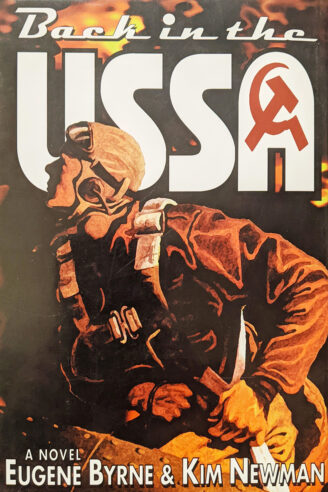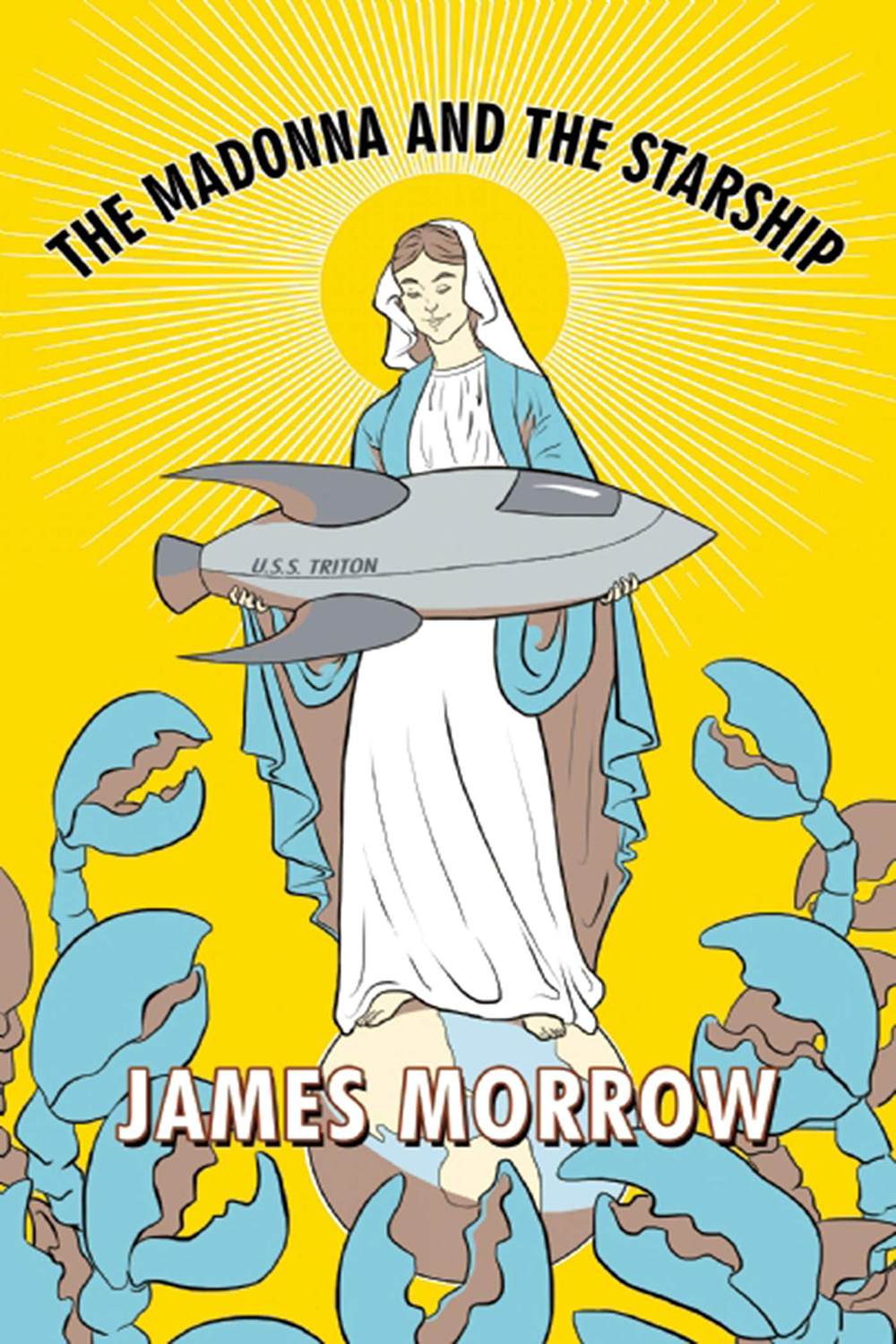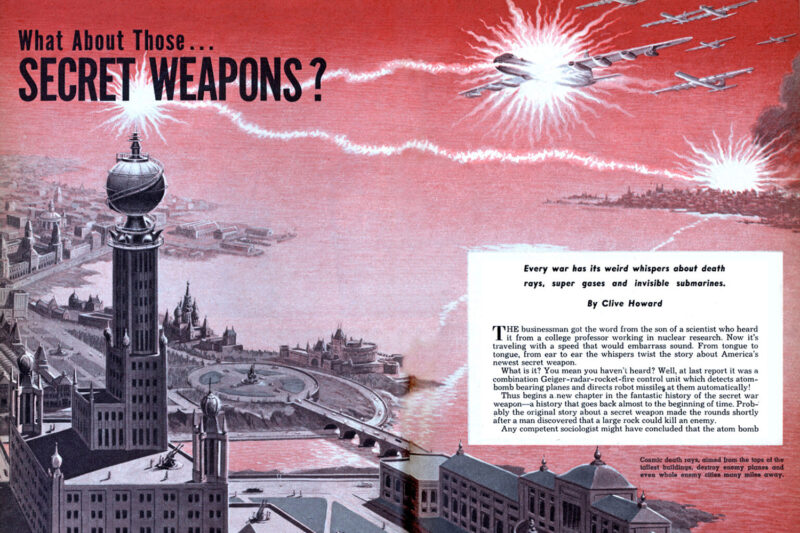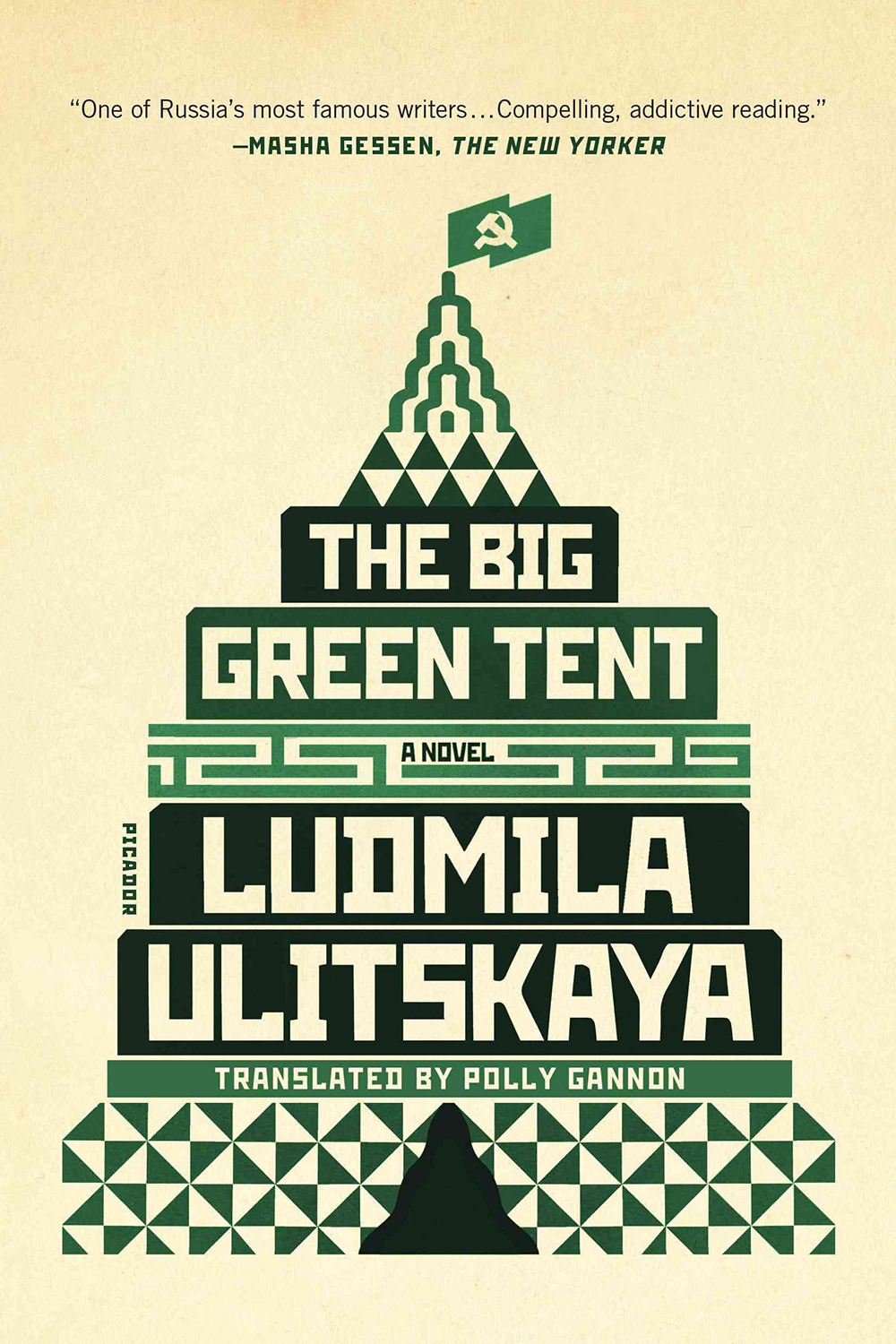In some respects, alternate history is an examination of irony. There are many examples of serious alternate history. There are moments when characters reflect on how our own history is implausible or unthinkable. For something more tongue-in-cheek, Eugene Byrne and Kim Newman took the United States, capitalist and democratic and emerging victorious from the Cold War, and pasted the twentieth-century history of Russia, revolution and tyranny and eventual collapse, onto it in their 1997 collection Back in the USSA.
The history presented in the collection closely parallels our own only with the United Socialist States of America in the place of the historic Union of Soviet Socialist Republics, with the United Kingdom and a reformed Russian Empire splitting duties as the United States equivalent. This parodic take on twentieth-century history is peppered with existing objects from popular culture portrayed as real figures, rubbing shoulders with our own historical figures in new situations.
Back in the USSA is not a novel but a collection of seven short stories previously published in Interzone magazine, some of which work better than others. The main attraction of the collection is in seeing the society, locations and individuals of the United States functioning under a government directly lifted from the Soviet Union, and it is something the novel accomplishes very well.
A passing familiarity with the history of both the United States and the Soviet Union is necessary in some respects to be able to fully appreciate Back in the USSA.
This is most apparent in “Ten Days That Shook the World,” where Americanized equivalents of the assassination of Alexander II, the Eastern Front of the First World War, the assassination of Grigori Rasputin, Vladimir Lenin’s arrival at Finland Station and the Polish-Soviet War are presented in an overall transplanting of the Russian Revolution to the United States in the 1910s. Perennial Socialist Party of America presidential candidate Eugene V. Debs becomes the Vladimir Lenin equivalent, but similar to how Joseph Stalin would eventually ascend to replace Lenin building a cult of personality around himself and ruthlessly crushing any opposition to his rule.
The American equivalent to Stalin is Al Capone, one of the inspired choices made by Byrne and Newman. The Capone tyranny eventually gives way to rule by Barry Goldwater and then Richard Nixon, fulfilling the historical roles of Nikita Khrushchev and Leonid Brezhnev, respectively, before stagnation eventually catches up with the country and it collapses under the reformist Kurt Vonnegut, standing in for Mikhail Gorbachev.
The rest of world history broadly follows the same path, only with the United States and Russia swapping places, with the United Kingdom helping the latter in fulfilling the role of the former. The Nazi Party still rises to power in Germany, the Second World War still comes and is won by the Allied powers, which soon give way to a Cold War between East and West.
Of course, here it is the democratic, capitalist and imperialist East against the totalitarian, communist and revolutionary West with the accompanying changes. France fulfil the role of both Cuba and the People’s Republic of China, the UK and Russia are bogged down in an intractable war in South East Asia against an enemy backed by the USSA, Chuck Yeager is the first man in space and the Russians are the first to land on the Moon, among many other switches.
This broad goal of this parallelism is indicative of the intent as not a wholly serious counterfactual but rather a parody of the US-Soviet relations during the Cold War by swapping their historical roles.
This is evident through such asides like Vimto becoming the symbolic representation of the consumer goods available under a capitalist system in the same way Coca-Cola was historically in the former Warsaw Pact. As well as the ironic usage of noted American anticommunists like Barry Goldwater, J. Edgar Hoover, Curtis LeMay, Charles Lindbergh, Joseph McCarthy, Richard Nixon and John Wayne as leaders or apparatchiks of the USSA.
Another of the major aspects of the novel that lends credence to the notion that it is not a wholly serious look at a counterfactual history is the intertextual use of existing fictional characters, objects and organizations to lend color to the fictional world presented therein.
The use of intertextuality in Back to the USSA serves to add another level to the parallelism presented where there was not an entirely appropriate equivalent figure from US history to slot into a Soviet role. It also serves as Easter eggs and moments of humor throughout the stories.
This is actually a major hallmark of the works of Kim Newman, not limited to this collection. It can also be seen in his Anno Dracula series and in numerous short stories. Back in the USSA, co-written with Eugene Byrne, is no exception to this. Fictional characters from literature, film, television, comic books and yet further media populate the collection rubbing shoulders with actual historical personalities and the odd original creation for the work.
A major example of this is the equivalent of Tsar Nicholas II being Charles Foster Kane, central character from the 1941 film Citizen Kane directed by Orson Welles, his final word that kicks offs the events of the film unheard by the revolutionaries who are with him for his dying moments.
Other examples include John Steinbeck’s Tom Joad from the 1939 novel The Grapes of Wrath, here a dissident hunted by real-life figures Elliot Ness, Frank Nitti and Melvin Purvis; as well as the protagonists of the BBC sitcom The Likely Lads being the protagonists of the story “Teddy Bears’ Picnic,” where they are sent to Indo-China as part of the British Army.
Even more are mere side characters or cameos from works as disparate as The Blues Brothers, Chinatown, Kes, Punch, The Silence of the Lambs, Thunderbirds and many, many more.
This myriad of sources does lead to some confusing paradoxes. For instance, in the aforementioned “Teddy Bears’ Picnic,” British Army recruits are put through a horrific training regimen by Sergeant Grimshaw of the film Carry On Sergeant, where he was portrayed by William Hartnell. Later in the story, a film based on the real experiences of the story’s protagonist sees the same Hartnell cast in the role based on Sergeant Grimshaw; the protagonist is aghast they have cast the lead of Doctor Who in that role. Hartnell also starred in Doctor Who in reality, hired in part due to his performance in This Sporting Life that he had taken to get away from the hard figures he portrayed like Grimshaw. So, the actor would not have appeared in the role without the earlier role that was unfictionalized in Back in the USSA.
Confusing matters still, a brigadier named Lethbridge-Stewart, himself a character from Doctor Who, appears as a real person in the same story and Patrick Troughton, Hartnell’s replacement on Doctor Who, is referenced as never having obtained the role in the world of Back in the USSA. Confused yet?
Regardless of whether or not the intertextuality is overanalyzed to a metaphysical extent as your reviewer is wont to do, the question has to be asked is it at all necessary? The inclusion of the fictional newspaper magnate turned politician created by Orson Welles in the role of America’s tsar does add something to the collection, but nothing that a real figure such as William Randolph Hearst (the inspiration for Charles Foster Kane, whom Hearst felt was so obviously based on himself that he tried to stop the film’s release and have all copies destroyed) would also have brought. The intertextuality makes less sense here than it does in Newman’s outright horror and science-fiction work, but it cannot be said that it detracts from the rest of the work.
Back in the USSA‘s intertextuality brings a certain something to the parallel history presented in the collection, but how do these two elements translate into the actual stories presented within the collection?
The parodic take and intertextuality make Back in the USSA of some interest on those merits alone, but are the individual stories contained within the collection of the same merit?
Unequivocally the best story within the collection is the opener “In the Air,” the second story to be published in Interzone magazine in January 1991, less than a year before the Soviet Union would cease to exist. The frame narrative sees British reporter Lowe attempting to interview underground musician Charlie Holley (better known by Buddy Holly in our own history) while the US is in the process of going through its glasnost and perestroika equivalents. Holley tells Lowe of an incident from his formative years when his hometown was visited by a troupe of propaganda war hero aviators coinciding with the arrival of two flying vagrants, indirectly leading to Holley taking up music for the first time. Both the frame narrative and the story within hold the readers interest. We find out just enough about the world in which the story takes place without being inundated with info-dumps, the historical personages used are varied and each bringing their own flash of irony to the proceedings. Special mention goes to Hunter S. Thompson as a faceless bureaucrat and Howard Hughes as a legendary folk hero.
The other good stories in the collection are those that concern themselves with the USSA and its society. “Ten Days That Shook the World,” first published in 1988, portrays the events leading to the Second American Revolution through a series of vignettes giving us a broad overview of the events that lead to the alternate America. A nice point is how the few characters portrayed across multiple vignettes change in attitudes and personalities over the course of the five years portrayed, including Ernest Hemingway. “Tom Joad,” published in 1992 and set in 1937, gives a great look at the USSA at the height of the Capone tyranny, and its conclusion is genuinely exciting and poignant. A nice Easter egg in this story is a cameo from Lyndon B. Johnson as a drunk hobo riding the rails along with fictional characters Boxcar Bertha and Charlie Chaplin’s The Tramp.
“Citizen Ed,” published in 1996 and set across most of the post-World War II era, is a fictionalized retelling of Ukrainian serial killer Andrei Chikatillo embodied in historical American serial killer Ed Gein. The hand of horror critic Kim Newman can be detected in this with multiple references to works derived from Gein’s crimes including Psycho, The Silence of the Lambs and The Texas Chain Saw Massacre.
The remaining story set in the USSA, “On the Road,” was first published in Back in the USSA itself, and sees the return of Lowe as he joins a roadshow run by newspaper magnate Robert Maxwell traveling down Route 66 bringing with them such embodiments of the benefits of capitalism as Cliff Richard and Vimto.
This story lacks something compared to those previously mentioned, but many of the funniest cameos are featured here including one Anthony Blair who worries in 1998 that he is too young to stand for Parliament. Of the two stories that take place outside the USSA, “Teddy Bears’ Picnic” is the better of the two and was even a finalist for the Sidewise Award in 1997. However, in some respects it is too long too packed with multiple narratives to be truly enjoyable for your reviewer. On the other hand, the recreation of Apocalypse Now with British public-school boys was grimly amusing.
The weakest story in the collection is “Abdication Street,” first published in 1996, set in the reformed Tsarist Empire in the 1970s in the lead up to a Royal Wedding between the fictional daughter of the equally fictional Nicholas III and the real-life Prince Charles. As the name might suggest, it is something of a send up of soap-opera plotting, but it does not work especially well. Particularly when so much of the background and worldbuilding details sound so much more interesting than the main plot. We see a conspiracy as to why the first men to land on the Moon never returned, see an equivalent of the Watergate scandal hit Imperial prime minister Henry Kissinger, and a riot between English and Russian football fans. Instead we are treated to the budding romance between Prince Charles and a television makeup girl, herself apparently the granddaughter of Leon Trotsky who in this history went on to be the equivalent of Charlie Chaplin. Even this subtle aside is much more interesting than the story it is contained in.
Overall the stories have more hits than misses, but depending on ones own personal preferences and how much you enjoy the in-jokes you might get a different level of enjoyment than your reviewer. Even then, a story I did not particularly care for was a finalist for the Sidewise Award — each to their own.
Is Back in the USSA one of the more plausible alternate histories out there? Certainly not! Instead it is a rare form of alternate history that parodies our own history putting people and places into the opposite of what they were historically.
Even rarer still is its use of intertextuality to further the parody with the inclusion of characters from existing works alongside historical figures.
The stories themselves can be a mixed bag depending on reader preference, but each should contain some measure of amusement at a couple points at the very least.
Is it time alternate-history parody made a return appearance alongside serious and fantastical iterations of the genre? Today’s scene seems ripe for an allegorical alternate history done tongue-in-cheek as something different.
This story was originally published by Sea Lion Press, the world’s first publishing house dedicated to alternate history.





